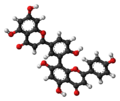Amentoflavone
-
Amentoflavone
-
Amentoflavone molecule ball
Amentoflavone[edit]
-
Amentoflavone chemical structure
-
Amentoflavone molecule ball-and-stick model
Amentoflavone[edit]
Amentoflavone is a naturally occurring biflavonoid compound found in several plant species. It is known for its potential pharmacological properties and has been the subject of various scientific studies.
Chemical Structure[edit]
Amentoflavone is a dimeric flavonoid, meaning it consists of two flavonoid units linked together. Specifically, it is a biflavonoid composed of two apigenin units. The chemical structure of amentoflavone can be described as 8-[5-(5,7-dihydroxy-4-oxo-4H-chromen-2-yl)oxy-4-hydroxy-2-(4-hydroxyphenyl)chromen-7-yl]-4H-chromen-4-one.
Natural Sources[edit]
Amentoflavone is found in various plant species, including members of the Selaginellaceae family, such as Selaginella tamariscina and Selaginella lepidophylla. It is also present in other plants like Ginkgo biloba and Hypericum perforatum (commonly known as St. John's Wort).
Pharmacological Properties[edit]
Amentoflavone has been studied for its potential biological activities, which include:
- Antioxidant Activity: Amentoflavone exhibits antioxidant properties, which help in neutralizing free radicals and reducing oxidative stress.
- Anti-inflammatory Effects: It has been shown to possess anti-inflammatory effects by inhibiting the production of pro-inflammatory cytokines.
- Antiviral Activity: Some studies suggest that amentoflavone may have antiviral properties, potentially inhibiting the replication of certain viruses.
- Neuroprotective Effects: Amentoflavone has been investigated for its neuroprotective effects, which may be beneficial in the treatment of neurodegenerative diseases.
- Anticancer Potential: Research indicates that amentoflavone may have anticancer properties, as it can induce apoptosis in certain cancer cell lines.
Mechanism of Action[edit]
The mechanisms by which amentoflavone exerts its effects are varied and complex. It is known to interact with multiple molecular targets, including:
- Enzyme Inhibition: Amentoflavone can inhibit various enzymes, such as cyclooxygenase and lipoxygenase, which are involved in inflammatory pathways.
- Receptor Modulation: It may modulate the activity of certain receptors, including GABA receptors, which are involved in neurotransmission.
- Signal Transduction Pathways: Amentoflavone can influence signal transduction pathways, such as the MAPK/ERK pathway, which plays a role in cell proliferation and survival.
Safety and Toxicity[edit]
While amentoflavone has shown promising pharmacological activities, its safety and toxicity profile in humans is not fully established. Further research is needed to determine its potential therapeutic applications and any adverse effects.
Related Pages[edit]
| Types of flavonoids | ||||||||||||||||||||||||||||||||||||||
|---|---|---|---|---|---|---|---|---|---|---|---|---|---|---|---|---|---|---|---|---|---|---|---|---|---|---|---|---|---|---|---|---|---|---|---|---|---|---|
|
Ad. Transform your life with W8MD's Budget GLP-1 injections from $75


W8MD offers a medical weight loss program to lose weight in Philadelphia. Our physician-supervised medical weight loss provides:
- Weight loss injections in NYC (generic and brand names):
- Zepbound / Mounjaro, Wegovy / Ozempic, Saxenda
- Most insurances accepted or discounted self-pay rates. We will obtain insurance prior authorizations if needed.
- Generic GLP1 weight loss injections from $75 for the starting dose.
- Also offer prescription weight loss medications including Phentermine, Qsymia, Diethylpropion, Contrave etc.
NYC weight loss doctor appointmentsNYC weight loss doctor appointments
Start your NYC weight loss journey today at our NYC medical weight loss and Philadelphia medical weight loss clinics.
- Call 718-946-5500 to lose weight in NYC or for medical weight loss in Philadelphia 215-676-2334.
- Tags:NYC medical weight loss, Philadelphia lose weight Zepbound NYC, Budget GLP1 weight loss injections, Wegovy Philadelphia, Wegovy NYC, Philadelphia medical weight loss, Brookly weight loss and Wegovy NYC
|
WikiMD's Wellness Encyclopedia |
| Let Food Be Thy Medicine Medicine Thy Food - Hippocrates |
Medical Disclaimer: WikiMD is not a substitute for professional medical advice. The information on WikiMD is provided as an information resource only, may be incorrect, outdated or misleading, and is not to be used or relied on for any diagnostic or treatment purposes. Please consult your health care provider before making any healthcare decisions or for guidance about a specific medical condition. WikiMD expressly disclaims responsibility, and shall have no liability, for any damages, loss, injury, or liability whatsoever suffered as a result of your reliance on the information contained in this site. By visiting this site you agree to the foregoing terms and conditions, which may from time to time be changed or supplemented by WikiMD. If you do not agree to the foregoing terms and conditions, you should not enter or use this site. See full disclaimer.
Credits:Most images are courtesy of Wikimedia commons, and templates, categories Wikipedia, licensed under CC BY SA or similar.
Translate this page: - East Asian
中文,
日本,
한국어,
South Asian
हिन्दी,
தமிழ்,
తెలుగు,
Urdu,
ಕನ್ನಡ,
Southeast Asian
Indonesian,
Vietnamese,
Thai,
မြန်မာဘာသာ,
বাংলা
European
español,
Deutsch,
français,
Greek,
português do Brasil,
polski,
română,
русский,
Nederlands,
norsk,
svenska,
suomi,
Italian
Middle Eastern & African
عربى,
Turkish,
Persian,
Hebrew,
Afrikaans,
isiZulu,
Kiswahili,
Other
Bulgarian,
Hungarian,
Czech,
Swedish,
മലയാളം,
मराठी,
ਪੰਜਾਬੀ,
ગુજરાતી,
Portuguese,
Ukrainian

